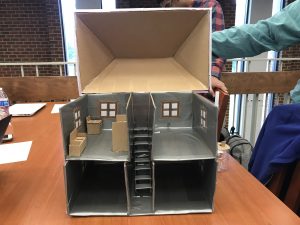Checkpoint #1
Problem #1 – housing structure
About 20 million people live in the slums in the Philippines, in housing structures that are temporary, unstable, and toxic causing many problems for the people living there. Materials such as cardboard, plastic, and tin are used for building but are not durable. “‘Durable’ housing means housing that is located away from natural or manmade hazards; is structurally safe, and protective against extreme weather” (WHO, n.d.). With extreme weather conditions, housing structures are destroyed and often have to be rebuilt. Poor housing structure causes the spread of infectious diseases such as dengue, cholera, and TB spread at a faster rate, not to mention the problem of overcrowding.
Problem #2 – toxic waste
Toxic waste is chemicals that can be in the form of a solid or liquid that is manufactured and released by industries to the environment every day. These chemicals contain toxins that can cause injury and death to humans, animals, and the environment. Many believe that the chemicals are all coming from commercial businesses like exterminators, dry cleaners, auto repair shops, hospitals, and industrial applications. However, most of the toxic wastes that harm our environment are found in our homes such as; motor oil, drain cleaners, oven cleaners, solvents, and paints. Chemicals should not be poured down the drain because once it’s poured down a drain it can poison the general water supply. When toxic wastes are poured on the ground, it will seep into the soil which will harm the environment. Waste thrown into trash will end up at a dump site where it will eventually be exposed to the surrounding environment.
Problem #3 – inadequate water supply
Over-crowding is one of the contributors to water shortage in slum areas. People are spending more money on water than they are spending on anything else. Because of water shortage, sanitization has also become an issue; which means that water shortage is causing other problems as well. Even if there is a water supply, it is hard to get the water unless someone powerful is involved in obtaining it. As some study shows, many people in slums use the well water which could be contaminated.
Problem #4 – Plumbing/waste
The waste problem in the Manila slums has contributed to various issues, one of which being sanitation. Emblematic of this issue is the infamous “Smoky Mountain” a man-made mountain consisting of tons of waste with communities gathered on top of them. Although that mountain no longer exists the issue of waste remains in slums all over the country. Man-made waste is an issue but so is human feces. One of the most prominent issues in the slums is the lack of toilets thus leading many people to defecate out in the open. As the residents scavenge what they can from the dumps for their survival they in the process they are also bringing home objects or food that are marred with feces that may cause diseases such as diarrhea and the millions of other viruses that are contained within fecal matter. This is a significant health concern particularly for children who are more likely to die from such diseases from fecal to oral transmission.
Problem #5 – warning systems for typhoons
The peak of the typhoon season coincides with the southwest monsoon, which brings increased rainfall and strong winds that can raise water levels along the shorelines of Manila Bay. The factor leading to vulnerability is the low-quality infrastructure of living conditions. Within the metropolis, it is estimated that one-fifth of informal settlers live in hazard-prone areas along waterways and the coastline. Land elevations are typically less than one to two meters above sea level, and with very limited structural protection measures along the coastline (such as dykes, sea-walls or revetments) most of the city is completely exposed to flooding from the sea. September 2011, Typhoon Pedring, caused severe flooding and damage to Manila slums. In the City of Navotas, 2,313 households were damaged, and about 2,000 households completely destroyed. Based on a survey, conducted in the study, of low-class families living conditions, 86% of respondents reported their houses were over water, while only 14% were situated on the land. 98% of houses are made of old wood and flimsy material. Since slums are mostly located on the shores and they don’t have the technology to detect, there needs to be a warning system.
The problem that we’re tackling –
The specific problem we decided to focus on for this project is the housing structure of homes for the people in Manila Philippines. The reason behind the housing structure being our focus is that improper housing for the citizens of Manila results in creating more consequences than any of the other problems we came up with. We agreed that this problem is a more efficient, cost-effective, and less time-consuming issue to resolve. The improper housing materials that the people of Manila are making their homes out of are not safe and reliable enough to support and protect their families from toxins, extreme weather, diseases, and unhealthy surrounding environments. Many consequences brought on by improper housing structures include; sanitation, outdoor & indoor air pollution, infectious diseases being spread at a faster rate, and many more. Because of all the issues listed above as a result of improper housing structures we have decided to focus on this specific problem.
References:
Alam, Z., Rahman, A., & Firoz, A. A. (2013, January 23). Water Supply and Sanitation Facilities in Urban Slums: A Case Study of Rajshahi City Corporation Slums. Retrieved from
http://pubs.sciepub.com/ajcea/1/1/1/Current State of Toxic Waste in the Philippines. (n.d.). Retrieved from https://stateoftoxicwasteinph.wordpress.com/
“Housing Related Health Risks”. (n.d.) World Health Organization. Retrieved from https://www.who.int/sustainable-development/cities/health-risks/slums/en/
In world’s poorest slums, landfills and polluted rivers become a child’s playground. (2015, February 12). Retrieved from https://www.pbs.org/newshour/world/in-worlds-poorest-slums-landfills-and-polluted-rivers-become-a-childs-playground
Life After Smokey Mountain. (n.d.). Retrieved from https://adb.exposure.co/life-after-smokey-mountain
https://adb.exposure.co/life-after-smokey-mountain
Morin, V. M., Ahmad, M. M., & Warnitchai, P. (2016, January 08). Vulnerability to typhoon hazards in the coastal informal settlements of Metro Manila, the Philippines. Retrieved from https://onlinelibrary.wiley.com/doi/epdf/10.1111/disa.12174
Siegel, Ethan. “This Is How Science Will Save Us From Hurricanes.” Forbes, Forbes Magazine, 28 Mar. 2018, www.forbes.com/sites/startswithabang/2018/03/28/this-is-how-science-will-save-us-from-hurricanes/#701545f11004.
Checkpoint #2
After coming up with 5 problems within the past few weeks, and finalizing on one, which is housing structure. We have come up with three solutions and chosen the one that we will implement.
Three Solutions
How to alleviate hazardous living conditions with new housing structures
- Community housing
- Community building and participation – people of the community in the slums will help build new durable housing that will consist of multiple rooms per house allowing multiple families to live within.
- Bringing the slums community together allows them to be involved
- Housing will be constructed with durable materials that will uphold extreme weather while also adapting to it
- Housing will include things such as a system for collecting rainwater
- By having families in separate rooms within an area, it decreases the risk of spreading infectious disease
- Use of natural resources such as trees, bamboo (if bamboo is being used a concrete stump must be put into place as bamboo will rot quicker if it is in contact with the ground)
- Build new houses using materials made from the waste products being currently used
- Cost-effective
- We can use a water bottle filling it with dirt or cement and stacking it on top of each other
- There is an abundance of plastic in the Philippines, so it is easily accessible
- It’s like reusing what is already there but makes better more durable housing
- Bamboo can also be used although it is not a waste product it will benefit the structure
- Eco-bricks – they are bricks basically made out of plastic; this goes with the water bottle used during construction
- The whole idea of this solution is to help get rid of waste (because there is an abundance of it) while reusing it into clean materials that can be used to build stable housing
- Hexagonal Housing
- This option is a little more costly in instance to the other two solutions but can still work
- Hexagonal housing is made from steel and foam panels
- Is quite durable against extreme weather
- Delivered by truck to whichever site we settle with
- Last 15-20 years roughly
- Houses can be combined to create larger homes (can be rearranged basically, customized to fit people’s needs)
- Basin that collects rainwater
- Solar panels
- Two ventilation shafts located on each side of the house
- This will allow ventilation because the walls and the ceiling are not completely connected
After coming up with three potential solutions, our next step was to create a decision matrix.
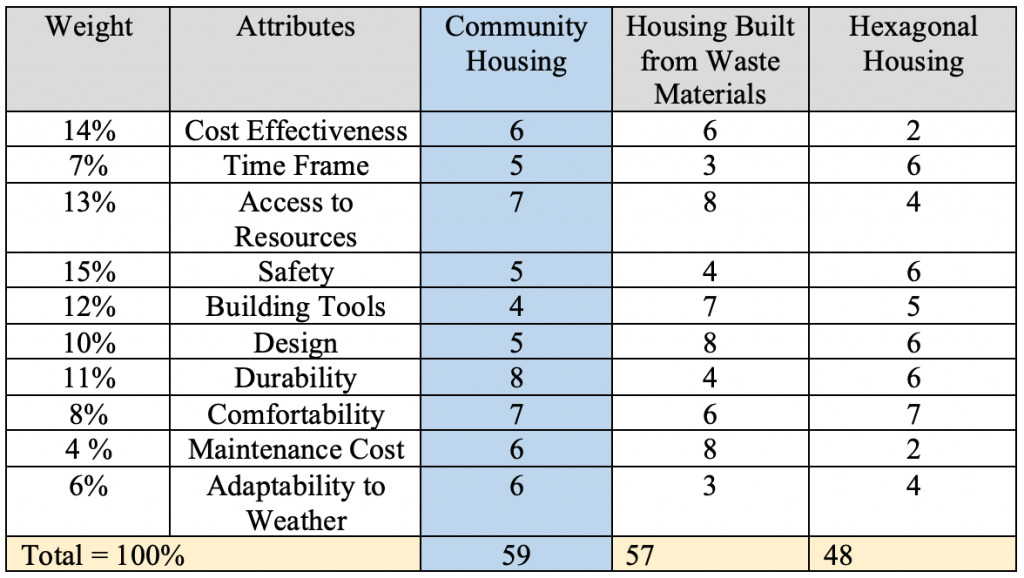
After completing our decision matrix, the final solution we chose to go with for our problem of alleviating hazardous living conditions with new housing structures is community housing.
Educational Piece – below is a rough draft of what will be included on our educational piece
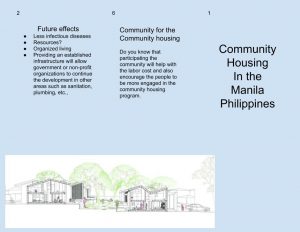
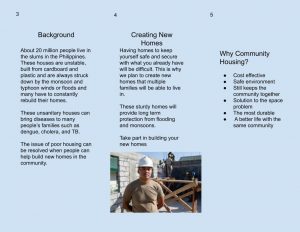
Checkpoint 3 –
Photos of our prototype (still in the works)
Since we have begun the construction of our house, this is what we have so far:
The roof –

The stairs –
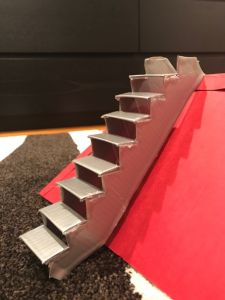
The housing structure itself –

We created an open view so that you can visualize what the inside of the house will look like.
What still needs to be completed for our prototype –
- Windows & doors
- Interior modeling to see how the homes will be set up for the families
- Stairs need to be attached to the house
- Water basin & gutters
- Plants for the top of the roof
Final Product

